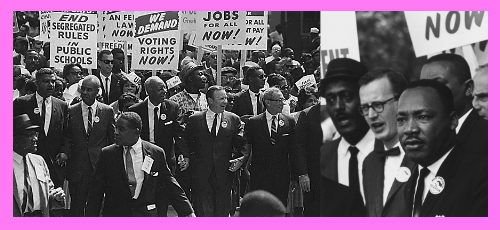


Inspiration for the Lesson:
- Debate among leaders of the Organization of American Historians as to when the Civil Right’s movement started
Implementing the Lesson:
- Student investigate a series of images related to the Civil Right’s Movement and select the top 2 they associate with the Civil Right’s Movement
- Teacher asks students questions about their top choices
- Teacher tells compelling stories of images without votes
- Class discusses criteria for determining the historical significance of an event
- Students come up with criteria similar to ones by Levesque
- Importance
- Profundity
- Quantity
- Durability
- Relevance
- Students come up with criteria similar to ones by Levesque
- Use their own criteria for historical significance to investigate events on annotated timeline that covers Civil Rights events from the 1900’s until today and try to answer the driving question: When did the Civil Right’s Movement begin?
- Students use this analysis of historical events to answer driving question and create a Birth Certificate that has
- Date of start of Civil Right’s Movement
- Parents of Civil Right’s Movement
- Event that started Civil Right’s Movement
- Student gains:
- learn greater context for events involve Martin Luther King, Jr. and Rosa Parks
- learn that Civil Rights figures did not magically appear, instead they were furthering goals of predecessors
- use analysis of evidence to make an evidence-based argument
- learn how to use their own criteria to establish the historical significant of events
Science Connections:
- The most famous committee that rewards scientists for making impactful discoveries is the Nobel Prize Committee
- A similar lesson can be designed that has students investigate the scientific significance of discoveries.
- In this lesson students can:
- develop criteria for the scientific significance of events
- analyze discoveries on an annotated timelines and try to identify the next winner of the Nobel Prize in a subject related to your course
- analyze discoveries on annotated timelines and try to identify who should have been the winners of the Nobel Prize due to their contributions in the understanding one a specific concept
- End product – Nobel Prize announcement that
- names the Nobel Prize winner
- explains the significance of the winner’s discoveries using the criteria for scientific significance determined by the students

In this lesson, students learn how to develop and use their own criteria to establish the significance of historical events. This skills teachers students how to use their own judgement to develop frameworks that can be used to analyze sources. While using their criteria to investigate several events in an annotated timeline, students learned a broader context for the events of the Civil Rights Movement.

Note: This is written for Science teachers. For tips for history teachers, read the book or the summary of the book chapter in the WHAT? section of this article above.
Preparation Steps
- Identify what concepts are the enduring understandings of your particular course
- Research to determine if any of the enduring understandings have underpinnings that include people and discoveries that are invisible in typical science curricula
- Research to find or create an annotated timelines that includes people and discoveries that both well-known and unknown to most science students
- Research criteria for the Nobel Prize. Decide whether you would like students to use the Nobel Prize criteria to determine scientific significance of a discovery or develop their own criteria.
- Create an image bank that can be used to launch the event:
- include both iconic and less well known images of concept being studied
- Design a project calendar with following phase:
- launch – initial investigate of images and selecting of top 2 iconic images
- review of criteria:
- students create criteria for scientific significance OR
- students restate Nobel criteria in their own words
- Students working in teams investigate discoveries on an annotate time lines and the criteria for scientific significance to determine which discovery should win the Nobel Prize in ______________ for contributions related to the concept of ____________
- Students compose a Nobel Prize announcement that includes name of prize winner(s), the discovery, the significance and impact of the discovery
Early Implementation Steps
- Implement project calendar described above
- Monitor students during individual investigation phase to make sure they are using scientific significance criteria to prioritize and rank discoveries
- Monitor students while they debate which discoveries deserve the Nobel Prize – make sure they are reference evidence related to the discoveries and scientific significance criteria
- During debrief discussions, probe for questions, understandings and misconceptions
Advanced Implementation Steps
- Get students to analyze discoveries of current scientists and predict who will win the Nobel Prize in 10 years – have them back their conclusions with evidence from the discovery and future impacts the discovery might logically have on technology and other branches of science

- PBL articles
- History articles
- Science articles
- Setting and testing hypotheses
